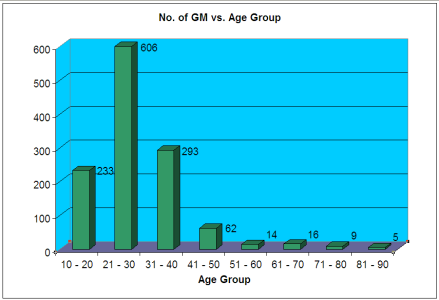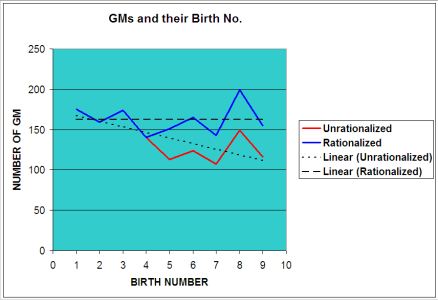Wikipedia has a list of all the Grandmasters, updated up to 2008 and contains 1267 names.
Our analysis of this list revealed some interesting information.
A. The Oldest and the Youngest to receive the title
Enrico Paoli (1908-2005) of Italy was awarded Grandmaster title at the age of 88, the oldest ever.
Sergey Karjakin (b.1990) of Ukraine was awarded Grandmaster title at the age of 12, the youngest ever.
B. They are not alone, others are close by
In the Senior group, there are 5 others who got their GM title after they crossed 80. They are:
- Jacques Mieses (1865-1954) of Germany got it in 1950 (Inaugural list) at 85 years
- George Koltanowski (1903-2000) of USA got it in 1988 at 85 years
- Vladimir Makogonov (1904-1993) of Azerbaijan got it in 1987 at 83 years
- Mario Monticelli (1902-1995) of Italy got it in 1985 at 83 years
- Esteban Canal (1896-1981) of Peru got it in 1977 at 81 years
Jacques Mieses would certainly have got it much before, had the formal rating system existed earlier.
In the Junior group, there are 8 others who got their GM title before they reached 15. They are:
| Name | Country | Year Born | Year GM | GM at |
| Parimarjan Negi | India | 1993 | 2005 | 12 |
| Etienne Bacrot | France | 1983 | 1997 | 14 |
| Bu Xiangzhi | China | 1985 | 1999 | 14 |
| Teimur Radjabov | Azerbaijan | 1987 | 2001 | 14 |
| Magnus Carlsen | Norway | 1990 | 2004 | 14 |
| Ngoc Nguyen | Vietnam | 1990 | 2004 | 14 |
| Wesley So | Philippines | 1993 | 2007 | 14 |
| Hou Yifan | China | 1994 | 2008 | 14 |
From above, you will possibly agree that prodigies are not bound by any geographical boundary!
C. The Patriarch of them all!
The oldest living Grandmaster is Andre Lilienthal of Hungary, born in 1911 and now 98 years old. We all wish to see him complete a well-deserved century!
D. The latest one
As per this list, the latest player to join the Grandmasters is Billy Joe Mills (b.1983) of USA who got the title this year (2009).
E. What is the most likely age for becoming a GM?
Excluding 27 Grandmasters who got the title in 1950 (the inaugural year for awarding title by FIDE) as it does not truly reflect when they reached the GM standard and another two names for whom birthdates are not available, there are 1238 names in the list. It is noted that the number of people who became GM in different range of age can be tabulated as below:
| Age Group | No. of GM | |
| 11 – 20 | 233 | |
| 21 – 30 | 606 | |
| 31 – 40 | 293 | |
| 41 – 50 | 62 | |
| 51 – 60 | 14 | |
| 61 – 70 | 16 | |
| 71 – 80 | 9 | |
| 81 – 90 | 5 |
This can be better projected by a chart as shown below:

It can be seen that two-thirds of the total number of GMs achieved it before they crossed 30, out of whom two-thirds achieved it when they were no longer ‘teenagers’!
F. Have the astrologers got something to say on this?
Discounting 10 names for whom birth month is not given, there are 1257 Grandmasters listed. Out of them, about 50% (617) were born in the first five months from January to May, almost uniformly distributed (average 124 per month). Rest 50% (640) were born in the later seven months from June to December, again almost uniformly distributed (average 94 per month). With reference to overall monthly average of 105, the average for the first 5 months of the year is 20% more, whereas that for the next 7 months is 10% less.
Does it mean you stand a better chance of being a Grandmaster if your birthday falls during January to May?
G. Does Numerology reveal any pattern?
For those who do not know about numerology, it is a sister (I do not know why FATE is taken as a woman, I’m just following the convention) to astrology, Numerologists hold that numbers (represented by your birth date, full date of birth, your house number, the numbers representing your name etc. etc.) hold significance for your life status!
Of course the date of the month when you were born is considered something of prime importance, so much so that you will find regular astrological columns in, newspapers, magazines etc. that run like ‘what this day/week/month/year holds for you if your birth number is 1, 2, 3, … 8, 9’!
Those uninitiated will ask: why up to 9 when there can be up to 31 days in a month?
Well, the numerology practitioners reduce all numbers to a single digit i.e., 1 to 9 (no 0 obviously). If it is a single digit date, no problem but for double digits, you keep adding the two digits till you get a single digit e.g., if you were born on 17th, it reduces to 8 (=1+7). If born on 29th, it reduces to 2. (2+9 gives 11 which in turn gives 1+1=2, got the idea?)
Leaving out 10 for whom birth date is missing, we checked the remaining 1257 in the GM list to find the distribution of the numerological birth numbers 1 to 9, counting as 1 all birth dates of 1, 10, 19 and 28, 4 for birth dates of 4, 13, 22 and 31, 9 for birth dates 9, 18, and 27, etc. The graph below shows the result.

You will find two zig-zag lines, one in RED other in BLUE, the lines for birth numbers 1 to 4 should be taken as common to both RED and BLUE. The RED graph depicts the number of GMs having a particular birth number e.g. 175 GMs with birth number 1 (which stands for birth dates 1, 10, 19 and 28), remembering that for numbers 1 to 4, the graphs are common.
The Black line with short dashes represents the trend pattern of the RED line. Ahh, see how that slopes down, the numerologists will say. Number 1 is tops! People with 1 as birth number has much greater possibility of being a GM than those with 9 as birth number!
Hold on for a moment, please. Do you know why I have plotted two lines? Has it occurred to you that whereas birth numbers up to 4 can cover 4 dates (though not in all months), numbers 5 to 9 can represent only 3 dates each? Statistically, would you expect more people under numbers 1 to 4 (each covering 4 dates) than under numbers 5 to 9 (each covering 3 dates)? You would, wouldn’t you?
To level the field, I RATIONALIZED for the inbuilt disadvantage for numbers 5 to 9 by using a multiplying factor of 1.33 (=4/3). The results are plotted as BLUE line for numbers 5 to 9. The trend line for this RATIONALIZED graph for numbers 1 to 9 (no rationalization was needed for 1 to 4, of course) is shown as a Black line with long dashes. And now what? This trend line is practically horizontal giving equal chance to all aspiring people for becoming a GM, whatever birth date they may have!
Well, if you say that even after RATIONALIZATION, those with 8 as birth number seem to have some edge, I have nothing to say!
Or may be something to say! Die-hard numerologists will trash all my statistics by using that famous quote on ‘three kinds of lies: lies, d—-d lies, and statistics’ ascribed to Benjamin Disraeli, but I do not know if Disraeli was a numerologist!


8 Comments
Interesting tidbits here.
It is all about being patient and playing non stop then and only then you can achieve what you are looking. If someone can get it at age 88 why not others?
I don’t believe in Numerology.
I wonder why Vishy is not in the list, he was pretty young when he got his GM as well.
Magnus is really a strong one in the list, he is in top 3 or something right now the kid is born to play chess such a talent but my favorite player is Topalov.
Vishy was not that young when he got his GM title, compared to the individuals mentioned. Vishy became popular later after 1992 – 1993.
It started after he won vs Kasparov and then from that time until early 2000 Vishy was growing in confidence and game play I remember him being always in top 5 chess players but later he became such a great player, won the championship and also got to rating of 2803 which is a great feat. He is more of a positional chess player similar to kramnik in a way. Anand is more defensive though and a great End game player.
@MarkB
Everyone is entitled to his own beliefs so long as those (a) are not imposed on others, (b) do not cause harm to others, and (c) are not detrimental to oneself also.
@Ralphe
Anand became GM at the age of 18. The list does not even include Fischer who became GM at the age of 15 years 6 months. We have included only those who got it before they were 15, just to keep the list short, nothing else.
Trackbacks/Pingbacks